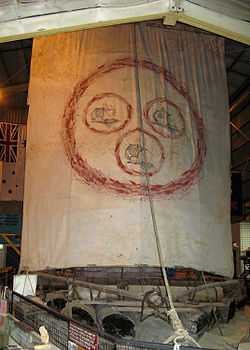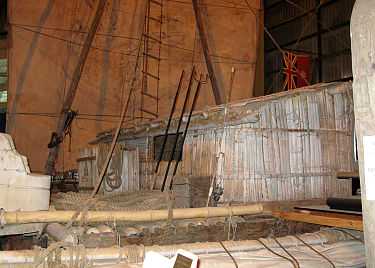Las Balsas

The 1973 Las Balsas expedition was the first (and so far only) multiple-raft crossing of the Pacific Ocean in recent history. It is the longest-known raft voyage in history.[1]
The expedition was led by Spaniard Vital Alsar who, in 1970, led the La Balsa expedition, only on that occasion with one raft and three companions. The crossing was successful and, at the time, the longest raft voyage in history, until eclipsed in 1973 by Las Balsas.
Expedition
The purpose of the 1973 expedition was three-fold:
- to prove that the success of 1970 was no accident.
- to test different currents in the sea, which Alsar maintained ancient mariners knew as modern humans know road maps.
- to show that the original expeditions, directed perhaps toward trade or colonisation, may have consisted of small fleets of balsa rafts.
Crew
The expedition consisted of three rafts, twelve sailors and three cats. Each raft had four crewmen and one cat.
The crew was made of several nationalities: Vital Alsar, captain of the Guayaquil from Spain, Marc Modena, captain of the Mooloolaba from France, Jorge Ramirez captain of the Aztlan from Mexico, Fernand Robichaud, Greg Holden and Gaston Colin from Canada, Tom McCormick, Tom Ward, and Mike Fitzgibbons from the USA, Hugo Becerra and Gabriel Salas from Chile and Anibal Guevara from Ecuador.

Rafts
The rafts were: the "Guayaquil" for the point of departure, "Mooloolaba" for the intended point of arrival in Australia, and "Aztlan" for Mexico, the place where the expedition was organized. These rafts were replicas of the ones used by South American natives for centuries before Spanish explorers arrived in 1526.[2]
The rafts were each 46 feet (14 m) long and 18 feet (5.5 m) wide. They were constructed with seven balsa wood logs which were cut down in the jungles of Ecuador from female trees during the full moon when the sap content was at its optimum thus ensuring its resistance to saturation by sea water. They were then floated down river to the naval base at Guayaquil for construction. The rafts are entirely built from wood with wooden pegs and sisal ropes for rigging. They were not capable of turning around when being carried by currents. They could maneuver with the use of centerboards: short planks between the logs called "guayas".[2]
They carried enough water for a few weeks and after that they had to rely on rain water. Canned meat and vegetables were stocked but they were to rely on sea food as their main diet. In the hot weather each man had to drink a pint of sea water each day to compensate for the lack of salt from dehydration. Each raft had a short range radio for use in emergency and enabled them to contact land every third day.
Journey
Setting sail from Ecuador they commenced their drift across the Pacific Ocean via the Galapagos Islands, The Society Islands, The Cook Islands, Tonga, south of New Caledonia, and then saw land close to Mooloolaba, Queensland.[3] The weather was bad and the prevailing currents carried them down the coast to Ballina, New South Wales. HMAS Labuan followed their drift and it was decided to tow them into Ballina with the aid of the local people.
One raft was breaking up and close to foundering so it was abandoned and left to drift on and was eventually found by fishermen close to Newcastle. After 9,000 miles (14,000 km) and 179 days at sea the crews were given a heroes' welcome by the people of Ballina.[1]
Legacy
A documentary chronicling the expedition was subsequently produced, titled "The Pacific Challenge".[4] This film can be acquired from the Ballina Maritime Museum.[5] Las Balsas was the subject of an 11-minute radio documentary as part of the Witness series on the BBC's World Service in January 2014, which featured interviews from Mike Fitzgibbons and Gabriel Salas.[6]
The best parts of the remaining two rafts were combined to form one raft and the Ballina Shire Council built a museum to house the combined raft.[2] Each year thousands of world travelers are able to see this exhibition and marvel at this exploit of twelve men.[1][7] A 40th year anniversary celebration has occurred at the museum in November 2013.[8]
See also
- Pre-Columbian trans-oceanic contact
- Kon-Tiki
- William Willis (traveller) — solo rafting expeditions across oceans.
References
- ↑ 1.0 1.1 1.2 NPR—National Public Radio (U.S.): The 1973 Las Balsas expedition "Australia Celebrates A World-Record Ocean Crossing" . accessed 11.16.2013
- ↑ 2.0 2.1 2.2 Friends of Las Balsas: History . accessed 11.16.2013
- ↑ Friends of Las Balsas: Route Map . accessed 11.16.2013
- ↑ YouTube.com: "The Pacific Challenge"
- ↑ BallinaMaritimeMuseum.org.au: "The Pacific Challenge" DVD . accessed 11.16.2013
- ↑ "The Longest Ever Raft Journey". []. 2014-01-02. 11 minutes in. BBC. BBC World Service.
- ↑ BallinaMaritimeMuseum.org.au
- ↑ Friends of Las Balsas: 40th Year Celebration 1973-2013 . accessed 11.16.2013